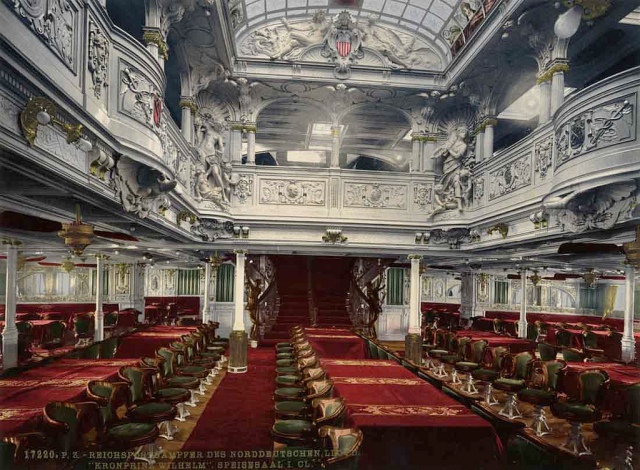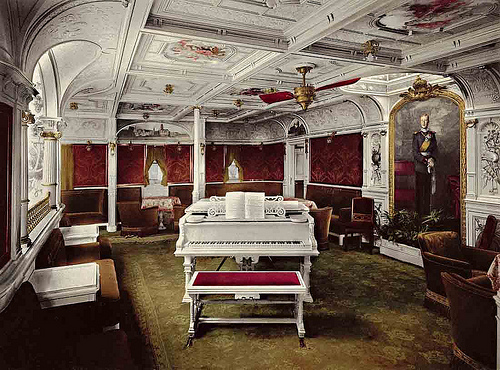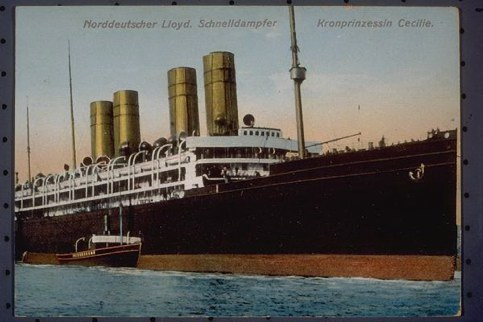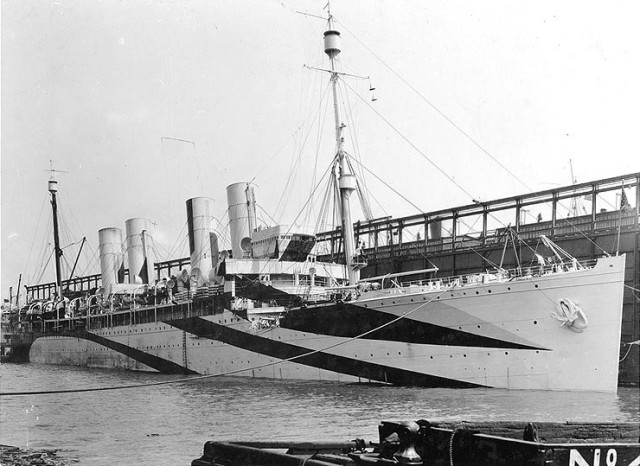The third four funneled liner from history was also German. Her name was Kronprinz Wilhelm. She was the successor to the wildly popular Kaiser Wilhelm der Grosse. She entered service in 1901 on the on the North Atlantic immigration route. She was quite fast and caught the Blue Ribband speed record in 1902. She was considered to have beautiful interiors. Her magnificent first class dining salon rose three decks with a glass dome overhead. Her suites were fitted out in the best satins and silks. As with the other German four funneled liners before her, she followed the pattern of pairing the funnels in pairs. A person could tell from a distance they were looking at a German greyhound. Germany was very proud of their new ship.
The onset of war means the ships that belong to the involved nations often get used for purposes other than what they were originally designed for. During the First World War, the SS Kronprinz Wilhelm became an armed merchant cruiser. She was to begin raids on allied commerce. She was staffed with a crew specially trained in search and seizure, expecting to capture ships belonging to the enemy. She was successful with at least 15 of these seizes. 


Coal is a very important element in the stories of the early superliners. It was the fuel for the engines. Without it, a ship can’t go much of anywhere. During WWI, coal supplies became very difficult to find. These big and fast ships burn tons and tons of coal in order to maintain speed. This fact and an outbreak of sickness aboard resulted in SS Kronprinz Wilhelm’s internment in 1915. She was laid up in Norfolk Naval Shipyard in Portsmouth. She was in American territory because the US was still a neutral country. She would be safe in this environment.
In 1917, after the sinking of the RMS Lusitania by a German u-boat, the United States entered The Great War. SS Kronprinz Wilhelm was seized by the US government and renamed USS Von Steuben. She returned to her previous war time roll of being an armed merchant cruiser, but this time for United States. By the time Von Steuben returned to the seas, America and the Allies controlled most of the Atlantic. There was not much need for an armed merchant ship. (Had she remained in German hands, she would have been more active.) Von Steuben was reassigned to be a troop transport. For four weeks she stayed along the American east coast, taking men and supplies from one port to another. On Halloween of 1917, she embarked on her very first transatlantic voyage under her new name. Von Steuben received a bit of damage from colliding with the USS Agamemnon, which was also began her life as a German ocean liner SS Kaiser Wilhelm II. This resulted in men being thrown off the ships forcibly due to the accident. Von Steuben headed to Halifax, Nova Scotia for coal in December of 1917 and was rocked by a massive explosion. This explosion was not on Von Steuben. It was the SS Mont Blank, a French ammunition ship. The explosion devastated the shore line and caused a tsunami wave to crash into the land. The blast could be heard and felt for miles. Von Steuben stayed to help on the scene. She then headed toward Philadelphia. During the next months she went to Cuba and Panama.
This ship made it’s way into history’s sunset in 1923 when she was scrapped, but not before having her name changed again to USS Baron Von Steuben,and then back again to Von Steuben. She was scrapped in Boston.



